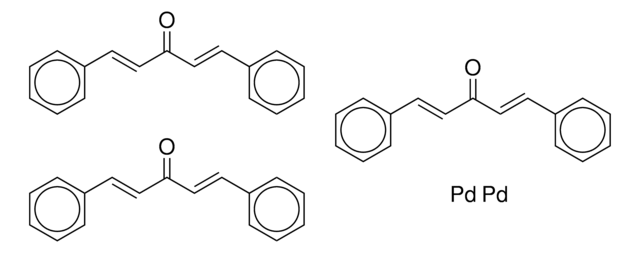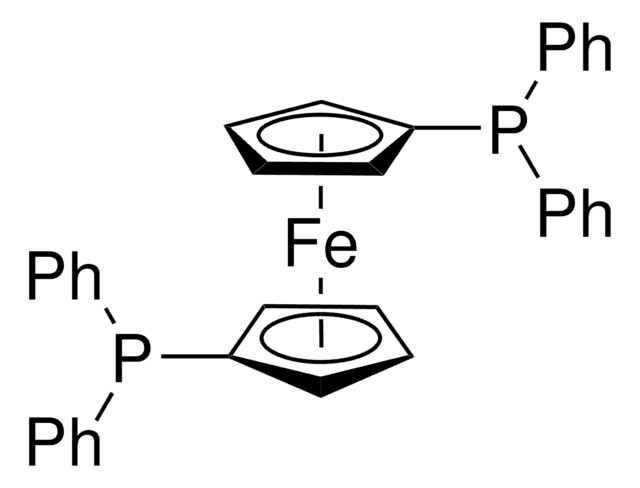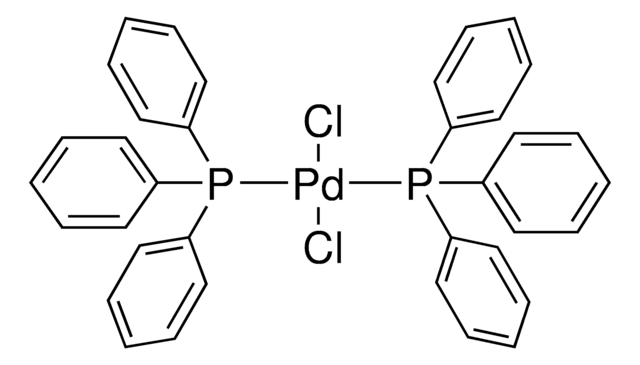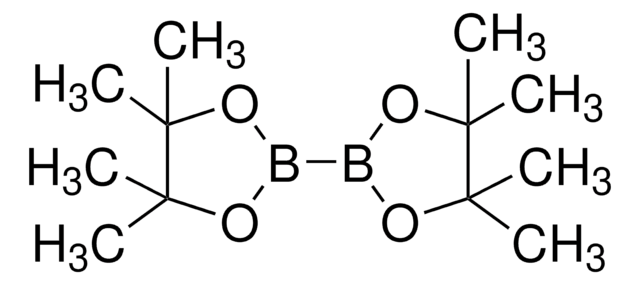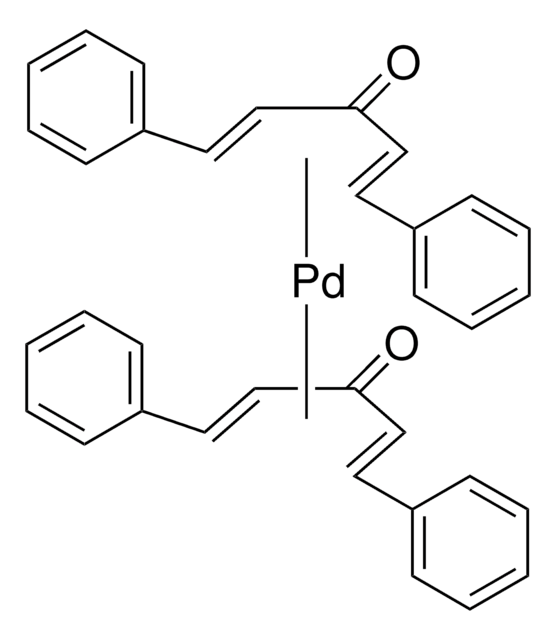919780
[1,1′-Bis(diphenylphosphino)ferrocene]dichloropalladium(II) ChemBeads
Synonyme(s) :
Pd(dppf)Cl2
About This Item
Produits recommandés
Forme
solid
Niveau de qualité
Composition
~ 4 wt.% loading of catalyst
Pertinence de la réaction
reagent type: catalyst
reaction type: Cross Couplings
Chaîne SMILES
[Pd+2].[Fe+2].P(c6c[c-H]cc6)(c5ccccc5)c4ccccc4.P(c3c[c-H]cc3)(c2ccccc2)c1ccccc1.[Cl-].[Cl-]
InChI
1S/2C17H14P.2ClH.Fe.Pd/c2*1-3-9-15(10-4-1)18(17-13-7-8-14-17)16-11-5-2-6-12-16;;;;/h2*1-14H;2*1H;;/q2*-1;;;2*+2/p-2
Clé InChI
NXQGGXCHGDYOHB-UHFFFAOYSA-L
Application
Pd(dppf)Cl2 may be used as an effective palladium catalyst in the following reactions:
- Cross-coupling of sec-alkyl and n-alkyl Grignard reagents with high yield and selectivity.
- Suzuki coupling of aryl boronic esters with [11C]methyl iodide to form functionalized [11C]toluene derivatives.
- Kumada cross-coupling of 1,3,5-tribromobenzene with Grignard reagents to form star-shaped oligothiophenes.
ChemBeads are chemical coated glass beads. ChemBeads offer improved flowability and chemical uniformity perfect for automated solid dispensing and high-throughput experimentation. The method of creating ChemBeads uses no other chemicals or surfactants allowing the user to accurately dispense sub-milligram amounts of chemical.
Learn more about ChemBeads products
For larger scale uses, product also available in powdered form (697230) & (931217)
Autres remarques
Versatile Methods to Dispense Sub-Milligram Quantities of Solids using Chemical Coated Beads for High-Throughput Experimentation
ChemBead Enabled High-Throughput Cross-Electrophile Coupling Reveals a New Complementary Ligand
Produit(s) apparenté(s)
Mention d'avertissement
Danger
Mentions de danger
Conseils de prudence
Classification des risques
Carc. 1B Inhalation
Code de la classe de stockage
6.1D - Non-combustible acute toxic Cat.3 / toxic hazardous materials or hazardous materials causing chronic effects
Classe de danger pour l'eau (WGK)
WGK 3
Point d'éclair (°F)
Not applicable
Point d'éclair (°C)
Not applicable
Faites votre choix parmi les versions les plus récentes :
Certificats d'analyse (COA)
It looks like we've run into a problem, but you can still download Certificates of Analysis from our Documents section.
Si vous avez besoin d'assistance, veuillez contacter Service Clients
Déjà en possession de ce produit ?
Retrouvez la documentation relative aux produits que vous avez récemment achetés dans la Bibliothèque de documents.
Articles
ChemBeads, catalyst-coated glass beads, offer a simple and cost-efficient solution for dispensing miniscule amounts of solid chemical reagents for nanomole-scale use in high-throughput reaction screening.
Notre équipe de scientifiques dispose d'une expérience dans tous les secteurs de la recherche, notamment en sciences de la vie, science des matériaux, synthèse chimique, chromatographie, analyse et dans de nombreux autres domaines..
Contacter notre Service technique![[1,1′-bis(diphénylphosphino)ferrocène]dichloropalladium(II)](/deepweb/assets/sigmaaldrich/product/structures/130/734/8846aa26-1858-458a-998d-8c306c13bf0f/640/8846aa26-1858-458a-998d-8c306c13bf0f.png)
![[1,1′-Bis(diphénylphosphino)ferrocène]dichloropalladium(II), complexe avec le dichlorométhane](/deepweb/assets/sigmaaldrich/product/structures/825/986/4317978b-1256-4c82-ab74-6a6a3ef948b1/640/4317978b-1256-4c82-ab74-6a6a3ef948b1.png)
